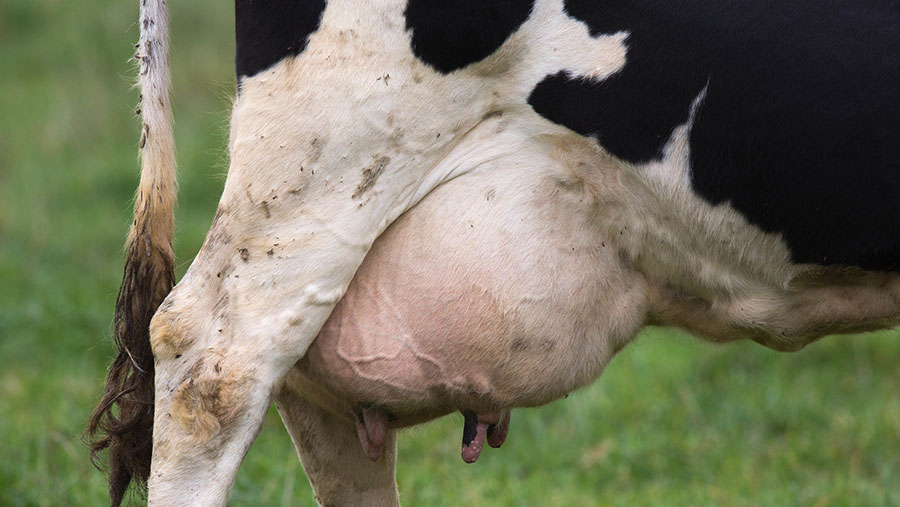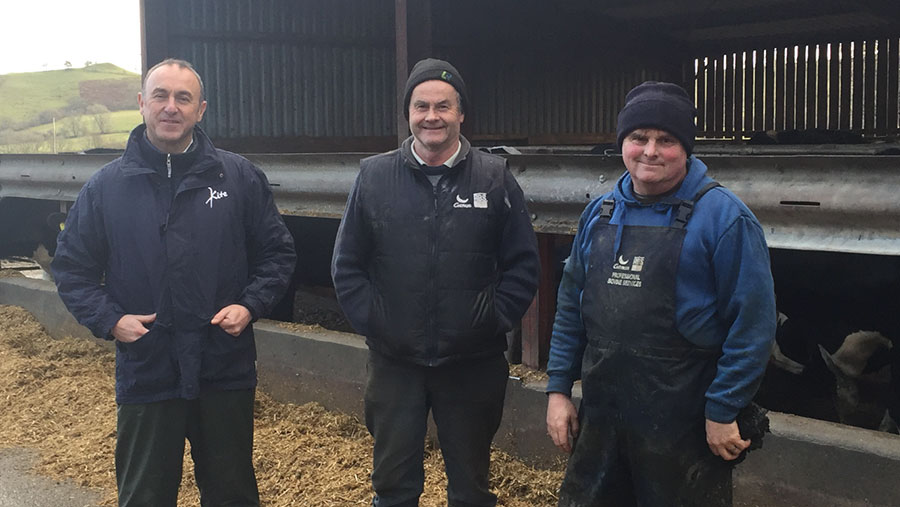How a Shropshire dairy farmer saved £60,000 in mastitis control
 © Tim Scrivener
© Tim Scrivener Implementation of the AHDB dairy mastitis control plan (DMCP) at one Shropshire farm has seen incidences of the condition halved in three years despite the milking herd increasing.
In 2014 mastitis cost Nantgoch Farm in Oswestry £118,000. Two years on, in the 12 months to 2016, the cost to the business, run by Bryn and Bev Jones along with son Matthew, totalled £62,000 – a saving of just under £60,000.
Specialist cattle vet James Breen and herd manager Nigel Jones explained the implementation and progress of the plan at the British Mastitis Conference on 15 November.
See also: Farmer checklist for reducing mastitis risk with robotic milkers
The situation in 2013
- 600 cows, all-year calving, total mixed ration fed.
- 9,250 litres, milking three times a day.
- Milkers grouped into high and low yielders and housed in cubicles. They were on treated paper and bed twice a week. Hydraulic scrapers used in passageways.
- Dry cows at pasture May to October and in cubicles
- Calving cows in loose yard, that was mucked out once a month. About 25 in at a time.
- About 20 people on the milking rota, with a lack of protocols. Teats were disinfected, but not dried properly.
- A very high rate of clinical mastitis, with some cows being tubed 14 times a week and some not curing at all.

(Left to right) Neil Blackburn (Kite Consulting), farmer Bryn Jones and herd manager Nigel Jones.
How was the plan determined?
James Breen, one of the vets trained as a “plan deliverer”, worked with the farm team and their vet to analyse all the available data. He looked at bacteriology, somatic cell count (SCC) and overall patterns of clinical mastitis.
Before the plan the numbers showed:
- In the 12 months ending 2013, 19% of cows calved in with a SCC greater than 200,000 cells/ml. “Effectively, one in five cows were calving down infected,” says James.
- There were 50-80 cases a year per 100 cows from 2009-2014.
- 45% of cows infected were only infected once, so there did not appear to be a recurrence issue.
- There were large numbers of cows infected in the first 30 days after calving.
Because it appeared the issue was not contagious and not recurring, it suggested a dry period environmental infection, so Dr Breen was able to focus on making changes to affect this infection stage.
What changes have been made?
They key changes, implemented in 2014-15, were made to the environment of the transition and calving cows, and to the drying off process:
Transition environment
Transition cows now have their own building because the low yielders have been moved out of the same shed.
There are 70 cubicles, but there is only feed space for 54, so they keep it below 54 cows in there. This allows more room for getting the cows organised and they stay in there until about 48-hours before calving, Nigel says.
The slatted floors were filled in and are scraped daily by a tractor. And the bedding was changed to deep sand, which is cleaned off twice daily and changed with new sand once a week.
Calving environment
The stocking rate has been reduced by keeping cows in the transition group for longer and the calving cows are now bed on straw, which is changed twice a week, and fully cleaned out every two to three weeks.
Drying off
“We try and keep it like an operating theatre now. There’s masses of surgical spirit,” says Nigel who oversees all drying off management with two other people.
An aseptic approach is used, with teats pre-dipped and then treated with surgical spirit and cotton wool, instead of wipes.
Nigel does the teat preparation and has two people focusing on tubing.
“I find having a head torch on helps a lot actually,” says Nigel, who also says they try to turn all dry cows on to a clean pasture.
What is the situation now?
In total, there has been a huge reduction in mastitis cases, from 631 cases in the 12 months to May 2013 to 375 cases in the 12 months to May 2016. This was driven by a reduction in dry period origin cases, from 247 to 97 (See ‘Improvements made in three years’, below).
The team now plan to concentrate efforts on maintaining the DMCP as well as focusing on other areas including:
- The lactation period, focusing on protocols and splitting high yielders up, to reduce the number of fresh cows in the high-yielders’ shed.
- Review scrapers because passageways are getting dirty again since abrasive sand is wearing the hydraulic scrapers out. The farm is trialling a road scraper as the passageways are too narrow for a tractor.
Improvements made in three years |
|||
|
Rolling annual average (April 2013) |
Rolling annual average (December 2016) |
Target |
|
|
Herd average somatic cell count (SCC) (cells/ml) |
248,000 |
158,000 |
<200,000 |
|
% herd >200,000 SCC |
25.6 |
13.9 |
<20 |
|
% herd chronic (more than one of past three SCC>200,000cells/ml) |
14.4 |
6.7 |
<5 |
|
Fresh calver infections |
19 |
12 |
<10 |
|
Dry period cures (%) |
77.2 |
74.7 |
>85 |
|
Dry period new infections (%) |
16.7 |
9 |
<10 |
|
Lactation new infections (%) |
14 |
7.8 |
<5 |
|
Cases clinical mastitis (per 100 cows a year) |
73 |
39 |
<25 |
|
Dry period origin first cases (per 12 cows at risk) |
2.07 |
0.66 |
<1 |
|
Lactating period origin first cases (per 12 cows at risk) |
4.17 |
2.45 |
<2 |
How has this affected antibiotics use?
The farm has seen a big drop in the use of antibiotics. They are using 1,242 fewer tubes than before the implementation of the DMCP.
In 2013, antibiotics use was:
- 40.39mg/population correction unit (PCU)
- 14.39 defined daily dose (DDDVet)
- 5.08 defined course dose (DCDVet)
In the 12 months to September 2017, this has fallen to:
- 24mg/PCU
- 4 DDDVet
- 2 DCDVet
How the plan works (AHDB Dairy)
Step one: looking at farm data
Milk-recording data and clinical mastitis data for at least the last year will be reviewed by a plan deliverer (PD). To be most effective, this data should be electronic, for example, copy of on-farm software coupled with milk-recording data from a milk-recording organisation.
The PD will then analyse the data in detail, looking for patterns of seasonality and diagnosing whether the majority of infections in your herd stem from the dry period or the lactating period and whether infections are predominantly from the environment or spread from other infected cows.
The PD may also want to do some bacteriology in order to make a diagnosis.
Step two: farm visit
An on-farm questionnaire and survey will then be undertaken by the Plan Deliverer. All areas of the farm will be looked at and management practices observed, including at least one milking. The areas that will be most closely examined are:
- Cow housing, including dry cows and heifers
- Milking parlour function and milking routine
- Management of the dry period
- Treatment of mastitis
- Other areas such as biosecurity and youngstock management
Step three: action plan
The collected data and information from the questionnaire will then be evaluated and a list of specific action points generated.
Action points will be prioritised into “must”, “should” and “could” categories depending on their significance in tackling the mastitis and somatic cell counts issues.
The PD will then use their clinical judgement to decide which action points will have the biggest effect and should be addressed as a priority.
Discussions between the PD and farmer will take place to go through the action points and discuss how they can be best implemented.
A plan of action will be decided together and a date for review will be agreed, usually three months from the first visit
